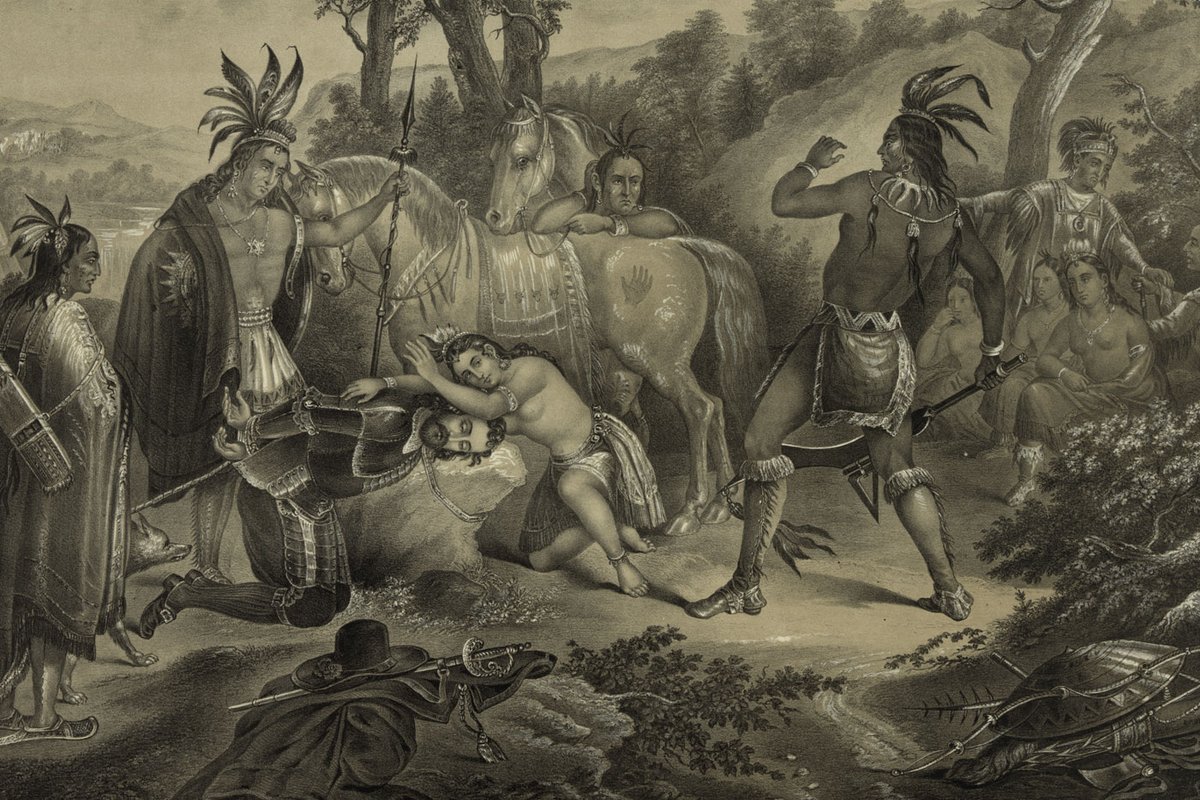
Pocahontas & John Smith
The Love Story Was Fiction...but Loved
The love story is entirely fiction. When John Smith met Pocahontas, she was 10 or 11 years old. Pocahontas did later marry a colonist, but the colonist was John Rolfe, not John Smith.
Still, the origins and evolution of the love story reveal much about how Americans have thought about their early history.
The Storytellers
Among those who told the story of the colonists’ interactions with Native Americans was Smith himself. In his Generall Historie of Virginia, New-England, and the Summer Isles, Smith described how he was captured by Powhatan warriors and how Pocahontas, the daughter of the Powhatan king, threw herself between Smith and the clubs of her father’s warriors. But Smith said nothing about a love story.
Colonists must have told stories about the pair because the Marquis de Chastellux, a Frenchman, reported that he heard some when he visited Virginia in 1782. As Chastellux told the story in his Travels in North-America, in the Years 1780, 1781 and 1782, when Pocahontas and Smith were reunited during her 1616 visit to England, she “threw herself into his arms.” But Chastellux’s Pocahontas saw Smith more as a father, not a lover.
It was not until 1803 that an Englishman, John Davis, embellished the story in his Travels of Four Years and a Half in the United States of America; During 1798, 1799, 1800, 1801, and 1802. He turned what he called the “broken fragment” of Chastellux into a true romance. Davis added a few years to Pocahontas’ age and wrote that she “obeyed the invitation of Captain Smith to wander with him...along the banks of the river” and then “gave loose to all the tumultuous extasy of love; hanging on his arm, and weeping with an eloquence much more powerful than words.” Davis conceded that Pocahontas married Rolfe, not Smith, but that was because Smith had stirred up her feelings. “The breast of a woman,” Davis explained, “is, perhaps, never more susceptible of a new passion than when it is agitated by the remains of a former one.”
Davis later expanded his tale in two 1805 works, Captain Smith and Princess Pocahontas, An Indian Tale and The First Settlers of Virginia, An Historical Novel.
North vs. South
For many of Virginia’s gentry, Pocahontas became, at least symbolically, an honored ancestor.
George Washington Parke Custis, the stepgrandson of George Washington, penned the 1830 play Pocahontas; or, The Settlers of Virginia. Custis’ Pocahontas was not motivated by lust but by Christianity, to which she converted. Similarly, in Charlotte Barnes’ 1844 play, The Forest Princess, or Two Centuries Ago, a pious Pocahontas has a vision of Native Americans and white people living in peace.
The appeal of these versions was that the love story suggested an attractive alternative history of how the white population spread across North America. If only more American Indians could have been like Pocahontas and taken on the ways of the settlers, many found it nice to believe, then so much bloodshed could have been avoided. In this sense, the love stories about Pocahontas and Smith were much like stories told of the first Thanksgiving in Plymouth: In both, English settlers and American Indians lived together peacefully.
As the Civil War approached, the Southern and Northern versions of a peaceful beginning competed, and New England’s version gradually supplanted Virginia’s in the imaginations of most Americans. More generally, many Americans came to think of Plymouth and not Jamestown as the place where America began.
“The story of one Indian girl’s bravery,” wrote art historian Ann Uhry Abrams, “could hardly compete with an entire army of self-righteous pilgrims.”
Still, Pocahontas and John Smith have remained a part of American culture. Musicians including Peggy Lee, Elvis Presley, Madonna and Beyoncé covered “Fever,” a song that includes lyrics about Smith and Pocahontas having a “very mad affair.” Hollywood too has been unable to resist the love story, which is central to Disney’s 1995 animated Pocahontas and Terrence Malick’s 2005 The New World.
Further reading
- Abrams, Ann Uhry. The Pilgrims and Pocahontas: Rival Myths of American Origin. Westview Press, 1999.
- Allen, Paula Gunn. Pocahontas: Medicine Woman, Spy, Entrepreneur, Dip-lomat. HarperSanFrancisco, 2003.
- Gray, Kathryn N., and Amy M. E. Morris, eds. Matoaka, Pocahontas, Re-becca: Her Atlantic Identities and Afterlives. University of Virginia Press, 2024.
- Horn, James. A Land As God Made It: Jamestown and the Birth of America. Basic Books, 2005.
- Mossiker, Frances. Pocahontas: The Life and the Legend. Alfred A. Knopf, 1976.
- Tilton, Robert S. Pocahontas: The Evolution of an American Narrative. Cambridge University Press, 1994.
- Townsend, Camilla. Pocahontas and the Powhatan Dilemma. Hill and Wang, 2004.
More from this Issue

